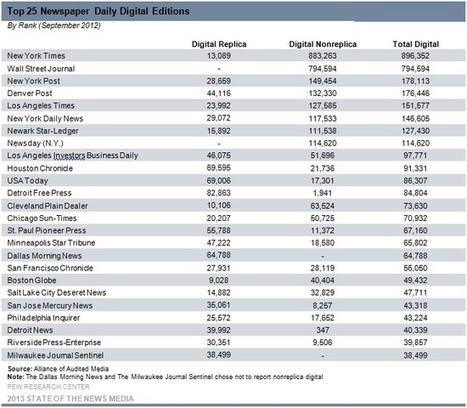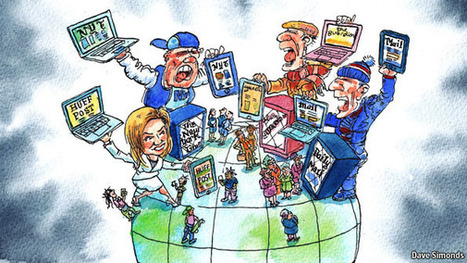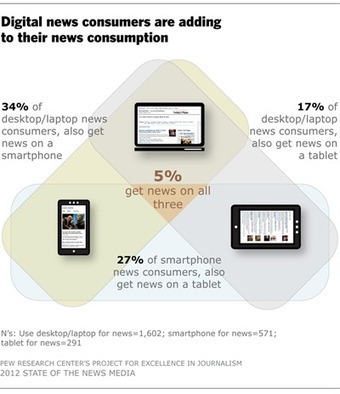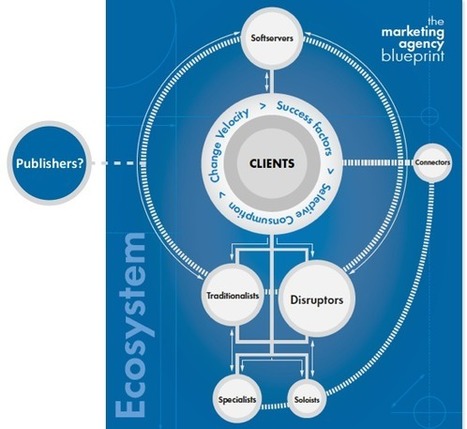 Your new post is loading...
 Your new post is loading...
...Up to 15 seconds of video, 13 custom filters, and a "cinema mode" for stabilization. Those were some of the features added to Instagram last week, instantly turning the popular photo-sharing app used by 130 million people into a video-sharing service. Within the first 24 hours of the announcement, over 5 million videos had been uploaded.Sure, some were of frothy lattes and the Miami Heat winning the NBA finals, but the new features have wider appeal than to just casual users.
As newsrooms are now relying on social media as a platform to discover and deliver the news, Instagram's new video features will add another piece of content into the mix for organizations: short, solid-looking video clips.Beth Bennett, assistant professor at The Medill School of Journalism, Media, Integrated Marketing Communications at Northwestern University, believes this will be the next big thing for news organizations....
Guardian digital development editor Joanna Geary answers some questions about GuardianWitness.... ...First up: this was built in two months. The sponsorship pot from EE gave them a budget and time to get the job done, but not necessarily have everything they wanted at launch. She says it's a complete, working system that can be built upon. I suggest the phrase "minimum viable product" to Jo but she suggests that it's a full product - one that will be built on. Do they have aspirations for more integration with social media? Yes, they do. And it's something they're looking at as the system develops. The key part of the development which is invisible to us right now is that the Guardian Witness system is deeply integrated with the Guardian's CMS. Once the content has passed through verification, it's available to the journalists, and they can insert it into a story or liveblog just by inserting an URL, which creates an embedded version of the contribution that links back to the contributor's profile. "The really exciting thing is not what you see now, but what you see when Witness is included in a story," she says. It's a tool to facilitate genuine collaborative working between the journalist and external witnesses. Jo says they'll collaborate with people on the ground, or with expert knowledge, in any way they can - and already do, via phone and other traditional methods. This adds another tool for doing that....
...At their core, Facebook, Tumblr, and Twitter are sharing networks, not publishing companies. They act as platforms for other people’s content, which can be spread rapidly and massively among their communities. A consequence of being walled gardens that restricts this sharing activity within their own properties, however, is that they give up the right to decide when and how that content breaks free into the wider public discourse. Even though it had success with its partnerships program at placing stories into other forums, Storyboard’s stories always had the whiff of marketing, or what is these days being described as “native advertising.” As we now know, that ultimately did not work out for Tumblr. Going by Fletcher’s comments, perhaps Facebook Stories will meet a similar fate....
News publications having “sponsored content “deals are on the rise, and Google’s apparently concerned enough that it’s issued a warning today that publishers should keep such content out of Google News. In a post today on the Google News blog, the company writes: "If a site mixes news content with affiliate, promotional, advertorial, or marketing materials (for your company or another party), we strongly recommend that you separate non-news content on a different host or directory, block it from being crawled with robots.txt, or create a Google News Sitemap for your news articles only. Otherwise, if we learn of promotional content mixed with news content, we may exclude your entire publication from Google News." Why such a warning now? Consider this...
If the newspaper industry had theme music in 2013, it might use “Been down so long it looks like up to me,” the much-recycled line from a 1920s blues song. For the first time since the deep recession that began in 2007, newspaper organizations have grounds for a modicum of optimism... Companies have started to experiment in a big way with a variety of new revenue streams and major organizational changes. Some of the bright opportunities – such as offering social marketing services to local businesses – are ventures too new to be measured yet industry-wide. They show signs of stabilizing revenue.... Even halting improvement in the general economy helps the industry. The double whammy of cyclical ad losses on top of secular shift to new media has considerably eased from the worst of the recession from 2007 to 2010. Auto advertising has come back, and some markets, like Miami, are beginning to see recovery in real estate and employment ads as well. All those positives, however, are for the time being mostly promise rather than performance. The most basic indicators have not turned around. The industry is little more than half the size it once was. Considerable dangers persist... So the industry entered 2013 with some positive signs but still dealing with difficult economic realities. The two biggest newspaper developments of the last year – digital paywalls and reduced print frequency – capture that odd mix of expansion and contraction now typical within the industry....
IN JANUARY the New York Times lost its top spot in comScore's ranking of the world's biggest newspaper websites to Britain's Daily Mail. The Times sniffed at the accuracy of comScore's figures, which exaggerate the Mail's online audience by including a personal-finance site that the paper owns. But the battle to be biggest reflects a growing phenomenon: national news publications going global. A mere one-quarter of the Mail's online readers are in Britain. The Guardian, which caters to those who like their news left-leaning and serious in contrast to the Mail's right-wing raciness, has one-third in Britain and another third in America (see charts). Their chief competitors are two American publications: the New York Times, which like the Guardian aims at readers of serious news, and the Huffington Post, which since its launch in 2005 has become the biggest site of the four (it is not in comScore's “newspaper” category). That the HuffPo is beating papers with a history stretching back to the 19th century is a sign of just how differently news works online....
...For the past few years, we as an industry have been asking (often with great consternation): What is a digital magazine? All of the magazine titles I mentioned are answering this question differently. Some have created a news feed. Others, a video channel. Many repurpose their print articles into blog posts. The smart ones have created a searchable archive of past issues. A few just beg you to download their app. When we ask the question that way, we open the floodgates to all sorts of slop that is decidedly un-magazine. The typical guru’s answer involves heavy-handed social media. And push notifications. And monetizing your online channel by paginating just below the fold, capitalizing on viral lift, and recalibrating expectations to include a mix of advertorial content and strategically placed calls-to-action powered by a new algorithm to maximize synergistic opportunities.
Gross....
...As more people in any given newsroom are publishing to social platforms — andas more people bypass the homepage and instead use Twitter and Facebook as the entry point to any given news site — analytics companies see new opportunities to help media companies leverage real-time social data. Visual Revenue, a predictive analytics firm that focuses exclusively on media companies, is this morning rolling out a bundle of tools to help editors measure the effectiveness of social publishing in real time. “So, if you push a story right now on Nieman Lab, 40 clicks into it you might see 17 retweets, two favorites, some manual retweets and that’s all great, actually,” Visual Revenue CEO Dennis Mortensen told me. “But how do you really add all of it up?”...
...Take Twitter for example. A wonderful way in which friends can talk to friends and friends of friends who are on the spot. But, if one has a look at who has large followings, a lot of journalists are right there. In almost every case, journalists who have the largest followers are those who are not only on the ball and on the spot but who have in successive 140 character messages been able to succinctly and accurately move information to their followers. Generally speaking, journalism needs to up its game. Professional hacks need to be able to place themselves on a much higher plane than so-called citizen journalists and bloggers. What they write and say has to be structured in a way that oozes professionalism and integrity, relevance and credibility....
|
Yesterday I quoted my old boss at the New Statesman. Today it’s Jon Snow, Channel 4 News presenter and Charlie Beckett who now runs Polis at the London School of Economics and was previously a programme editor at Channel 4 News. Both had interesting things to say about the evolution of news in the networked age. Both were talking heads in the final part of Steve Richards’ Making News series on Radio 4....
Today’s annual report on the State of the News Media shows that new technologies really are pressing journalists to do much more with much less. Last week, we learned that newspaper industry ad revenue was down 7.3 percent this year to its lowest level since 1984 (or 1954, adjusted for inflation). As a result, newsrooms continue to shrink. But The Project For Excellence in Journalism’s report shows us that the needs and demands of the audience are growing and fragmenting. Social media is an important source of news, the report says, but remains smaller and only “supplemental” to other discovery methods like directly visiting a news website, searching the Web or browsing an aggregator....
Or, put another way still, the paywall, other than providing a bit more time to wrestle with the underlining problems of newspapers, does not solve any of them. Even with this new class of free-spending readers, the economic problems remain exactly the same: • An extraordinary indifference, if not utter lack of interest, on the part of younger people to news brands and to news habits, a development that established news organizations have been unable to address, stall, or even fathom. • Dramatic abandonment of the medium by traditional advertisers, such that, since 2007, newspapers, according to industry monitor group Outsell, have seen more than a 40% decline in overall income, the overwhelming amount of that drop due to lost ad revenues....
Given the speed of the news cycle and the time needed video news production, social media is "the first way we break news now," says Andrew Springer, Producer of Social Integration at ABC News, in this interview with Beet.TV at SXSW.
The grizzled vet and the digital native: Journalism has plenty of room for both to succeed. I spent eight years at AOL and I'll say this: I saw none of the great, all of the bad and some of the good. ... The blood sport during my AOL days was about the future of media companies — who would or wouldn’t survive the digital onslaught. Actually, it was much the same during my time at Newsweek in the 80s (who needed three newsweeklies in a broadcast world). Ditto when I joined The New York Times in the 70s (was the city big enough for both The Post and Daily News). Now, the social Web with its echo chamber turns up the volume daily — and makes it more personal, too. It’s far more about the fate of the individual journalist. That quickly gets down to the paycheck. Will there be one? How much? Who gets it — the “professional” or the pretender? Consumer demand for credible news and information is greater than ever. The problem is the 100-year-old model for producing it is forever broken. That’s why more attention must be paid to finding new ways to produce quality journalism — efficiently, at scale and at a price supported by mobile CPMs, which at best are 50% lower than desktop CPMs, which if you’re lucky come in two-thirds lower than print CPMs. In other words, a high-cost newsroom structure built for the print age will never work in a smartphone or tablet world. A few startups are experimenting with new models — Vox Media, Machinima, Bleacher Report and Storify are a few that I follow. Among traditional media companies, FORBES is the only one I know of charting a new course....
Striking the right balance on social media channels can be difficult enough, but what if your brand is behind a pay wall? The Drum chats to the Financial Times’s social media manager Rebecca Heptinstall and communities editor Sarah Laitner about why the brand is still with the times as it celebrates its 125th year.Is there a certain platform you prefer working on? Rebecca Heptinstall: Twitter is very much the Financial Times’s favoured social network in sheer community size (2.75m) and traffic to FT.com. That’s not to say that other social networks aren’t important, they certainly are – for example, we were the first newspaper to reach 1m followers on Google+ in July 2012. We’re also figuring out what platforms fit with the brand as and when they pop up – for us it’s less about being everywhere and more about being represented well in a few places....
Tech site develops predictive platform to monetize traffic surges In an analytics-obsessed Web climate, everyone is chasing the big story. The problem is, more often than not, big breakout traffic scoops yield attention, eyeballs and notoriety, but very few dollars. Last month, Deadspin broke the story on the Manti Te’o girlfriend hoax, netting the site nearly 4 million pageviews. But as Gawker Media mentioned publicly following the story, the company had no technical solution in place to monetize an unforeseen surge in traffic. Gawker is not alone. Web publishers have struggled across the board with this, which is why Ars Technica has been hard at work with what could be a viable solution. At Ars Technica, Condé Nast’s 15-year-old high-brow tech site, Ken Fisher and his small in-house team were lamenting the traffic conundrum when they decided to build a real-time dashboard geared toward examining pageviews with a predictive eye toward recently posted articles that are poised to trend. "Within two days we found it was working really well," explained Ars editor in chief Fisher. “We were identifying within an hour stories that would go on to do 900,000 views. And these were not pieces you’d hear by title and think, ‘That’s going to be killer.’ One was titled, Quantum Networks May Be More Realistic Than We Thought.”...
Brands are becoming publishers, but do publishers have untapped opportunities as marketing agencies? ...Rather than viewing content marketing as their impending doom, publishers should be focused on the emerging opportunities: Create and distribute content, in and out of network.Produce sponsored content (aka native advertising).Tap existing advertising partnerships, and even consider cannibalizing their advertising business in favor of a more sustainable future.Offer integrated services (i.e. content + SEO + social + PR + email + analytics). Content alone isn’t enough. As Andrew Davis (@TPLdrew), author of Brandscaping, said in a recent Marketing Agency Insider post, “Publishers are masterful content creators, and they are able to charge a premium for the services they offer by leveraging theirmarket research, existing distribution platforms, and even the talent from their editorial teams.”
And Paul Rossi (@economistrossi), managing editor of The Economist, states on Digiday, "The opportunity for media companies is to create content that’s compelling for users on behalf of advertisers. That doesn’t mean it has to be native, but the skills in telling stories are quite valuable to marketers as they build audience themselves."...
|



 Your new post is loading...
Your new post is loading...























Instagram and Vine videos have provided a platform for users to view news instantly and share among their friends or through social media. Beth Bernett, assistant professor at the Medill School of Journalism, believes that video sharing on Instagram will become an essential tool for news organizations to share updates online. This in turn, will keep users engaged with live news updates, especially for those that don't watch the news frequently.